
€39.99
NETGEAR 5-Port Gigabit Ethernet Switch Price comparison
NETGEAR 5-Port Gigabit Ethernet Switch Price History
NETGEAR 5-Port Gigabit Ethernet Switch Description
NETGEAR 5-Port Gigabit Ethernet Switch: A Reliable Networking Solution
The NETGEAR 5-Port Gigabit Ethernet Switch is your go-to solution for enhancing your home or office network. With a compact design and powerful performance, this switch offers a seamless way to connect multiple devices reliably. Whether you’re streaming videos, gaming online, or running a business, the NETGEAR switch ensures high-speed connectivity with minimal lag. Dive into our comprehensive analysis, including price comparisons and customer reviews, to discover why this Ethernet switch is a must-have for any network setup.
Key Features and Benefits
- Gigabit Ethernet Speed: Experience lightning-fast data transfer rates of up to 1000 Megabits per second, perfectly suitable for high-bandwidth activities.
- 5 Ports for Multi-Device Connectivity: With five RJ45 ports, easily connect multiple devices such as desktops, printers, and game consoles.
- Quality of Service (QoS) Traffic Prioritization: Optimize your network traffic for smooth performance during heavy usage times, prioritizing critical data for essential tasks.
- Unmanaged Switch: Plug-and-play functionality allows for easy setup without complex configurations, making it user-friendly for everyone.
- Durable Metal Case: Built with a robust metal case, the switch is perfect for desk or wall mounting, designed to withstand daily use.
- Wide Temperature Range: Operating efficiently between 32°F and 122°F, it is suitable for varied environments, ensuring durability and reliability.
- Limited Lifetime Warranty: Confidence in your purchase with NETGEAR’s limited lifetime warranty guarantees parts and labor coverages, providing peace of mind.
Price Comparison Across Suppliers
Pricing for the NETGEAR 5-Port Gigabit Ethernet Switch varies across multiple retailers, reflecting its popularity and demand in the market. As of the latest analysis, prices range significantly, allowing you to choose the best option for your budget. By comparing prices, you can find the most cost-effective deal available. Our price history chart shows recent trends, indicating price fluctuations that can guide your decision.
Notable Trends from 6-Month Price History
The 6-month price history chart reveals stability in pricing for the NETGEAR switch, with minor dips and rises. This trend suggests a competitive market situation, making it a good time for potential buyers to purchase while prices are reasonable. Historical data indicates that during promotional events, prices may drop, so watch for limited-time deals to snag an even better bargain!
Customer Reviews Summary
Customers consistently praise the NETGEAR 5-Port Gigabit Ethernet Switch for its reliability and ease of use. Positive aspects highlighted in reviews include:
- Quick and easy installation with plug-and-play functionality.
- Sturdy build quality ensures longevity and resilience.
- Exceptional speed capable of handling high-demand applications seamlessly.
However, some reviewers noted a few drawbacks, such as:
- Lack of advanced management features, which might be a concern for tech-savvy users.
- Limited physical size for customized network setups in larger spaces.
Explore Unboxing and Review Videos
For visual learners, several YouTube reviews and unboxing videos showcase the NETGEAR 5-Port Gigabit Ethernet Switch in action. These videos provide insight into the installation process, practical demonstrations, and even comparisons to similar products, enhancing your purchasing confidence. Watching these videos can help you determine if this switch complements your networking needs effectively.
Why Choose the NETGEAR 5-Port Gigabit Ethernet Switch?
Choosing the NETGEAR 5-Port Gigabit Ethernet Switch means investing in a product that delivers speed, durability, and ease of use. It is perfect for both home users needing reliable internet for streaming and gaming, as well as for small business setups requiring efficient connection for multiple devices. With a focus on high performance and customer satisfaction, this switch is sure to meet your networking demands.
Conclusion: Compare Prices Now!
Don’t miss out on the opportunity to elevate your network’s performance with the NETGEAR 5-Port Gigabit Ethernet Switch. With robust features, excellent reviews, and a competitive price range, this switch is highly recommended for anyone needing reliable connectivity in today’s fast-paced digital world. Compare prices now and find the best deal for you!
NETGEAR 5-Port Gigabit Ethernet Switch Specification
Specification: NETGEAR 5-Port Gigabit Ethernet Switch
|
NETGEAR 5-Port Gigabit Ethernet Switch Reviews (12)
12 reviews for NETGEAR 5-Port Gigabit Ethernet Switch
Only logged in customers who have purchased this product may leave a review.

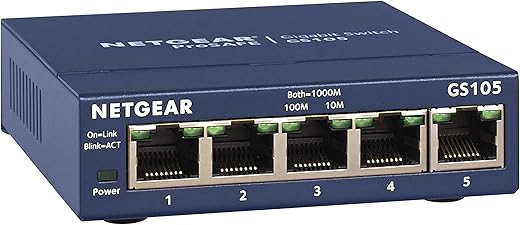
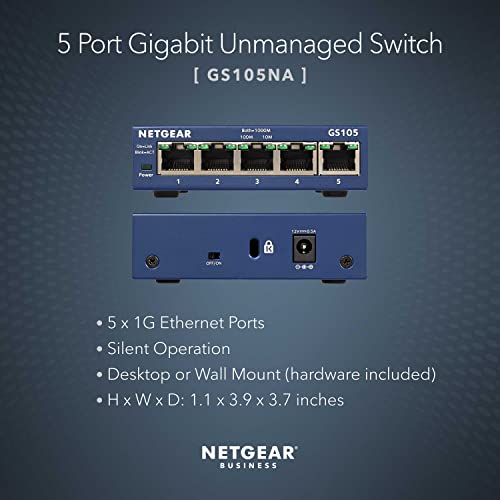
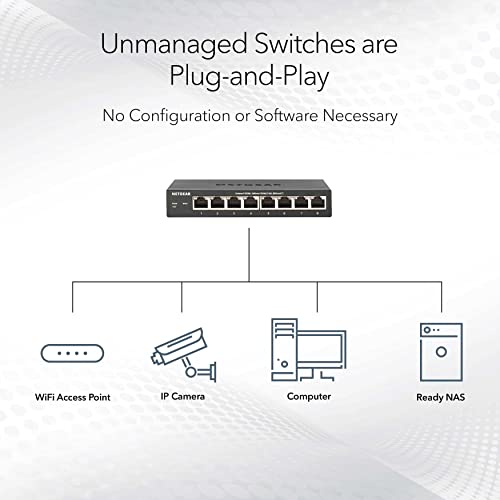
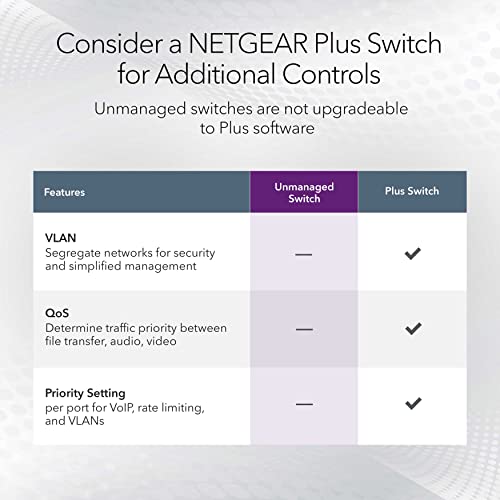
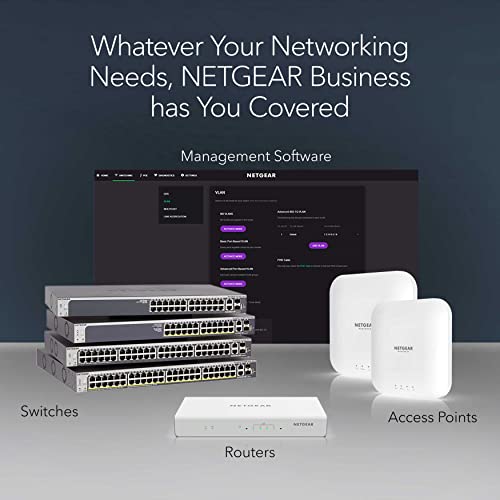






Luke C –
I bought a NETGEAR 5-Port Gigabit Ethernet Unmanaged Switch (GS105NA) more than 4 years ago, plugged it into my network (connecting my router and a few other devices via ethernet, including a computer, a TV, and a Nintendo Switch), and that was that: It. Just. Worked. And it has never stopped working! Without any fumbling about with settings or having to worry about ports dying or dropped connections etc. (knock on wood).
This discreet little unit runs 24-7 without a hitch, and without any advanced set-up or mataintenance being needed. Exactly what one wants from an unmanaged switch!
Recently I tried switching to a 2.5G switch from another brand. Theoretically this should’ve sped my network up tremendously, since I now have a router and multiple devices that support 2.5G ethernet… However, the new router turned out to be nothin’ but trouble, and ultimately I had to put this good ol’ Netgear 1G back into service instead, to keep the Internet and local services running properly for everyone in the house.
This made me appreciate just how trouble-free and reliable this quiet, affordable, unassuming little switch has been all of these years. Thus this review. Hopefully Netgear’s 2.5G switches are as good as this old warhorse.
Customer –
It seems that Netgear’s newer products with plastic casing have limited warranties. I paid a few dollars more and got the metal one with lifetime warranty. They can break after 5 or 10 years, but they send out a new one without any trouble. They are cheap enough to have a spare around for practically zero downtime and then you just replace the other one. They dont all break- but they stand behind them. I opened this box and set it up in less than 5 minutes. Great products.
Adam –
Product is not working
M. –
I needed a 5-port and an 8-port switch for my low-voltage installation. This 8-port gigabit switch is perfect.
Placed it in the low-voltage cabinet and it wrks flawlessly, feeding multiple 4K TVs and sound systems.
I have two of these switches (5-port and 8-port) and they are wonderful.
I’ll be a repeat buyer when I need more switching gear.
packetrat –
PROS:
– true 802.1q VLAN tagging support, at a very low price
– excellent wire-speed performance, tested @ 950+Mb/s in iperf on 6 ports at once, so long as Flow Control is disabled (see below). The main chip is a Broadcom BCM53128, which seems slightly faster and more efficient than the Realtek RTL8380 used on competing switches from TP-Link and Zyxel.
– very low power use, approx. 1W – 3W dependent on ports in use (~ 0.25W DC / 0.45W AC base plus 0.3W per connected 1000M port, or 0.2W per 100M port). Traffic levels seem not to affect this much, though cable length might, since it tries to use lower transmit power on short cables. The switch-matrix core runs on 1.2V, with 3.3V for I/O, both provided by efficient switchmode buck regulators (unlike some switches that use a hot-running, linear step-down from 3.3V to 1.2 or 1.8V, at < 50% efficiency).
– silent operation, with no fan or coil whine. Despite the lack of a fan, mine never even gets noticeably warm. There is a reasonably sized heatsink on the main chip, and a thermal pad under the PCB, allowing the case bottom to serve as an additional heatsink.
– good build quality. Just one electrolytic capacitor, which is a Nichicon (reputable Japanese brand) 220uF on the power input, over-rated at 25V when operating at 12V. Main switch chip is a Broadcom BCM53128. Case is solid metal, compromised slightly by a stick-on platic piece around the ports for labeling, which another reviewer complained about.
– happily runs on the variable 12V battery bus (10.5-14.4V) from an offgrid DC power system
– starts up quickly, from cold-powerdown to forwarding traffic in about 8 seconds, far faster than any “true” managed switch (Catalyst, Juniper, Procurve etc.)
CONS:
– management interface, whether via web or Windows app is limited and cumbersome, especially when configuring VLANs, though is most cases this is only a one-time annoyance, set-and-forget
– typical of switches in this class, there’s no CLI management, nor SNMP, so tracking port activity with MRTG, etc. is not possible. Omitting these probably does reduce both cost and power use, though.
– The management controller, integrated within the BCM53128 is a weak CPU derived from the 1980s-vintage, 8-bit Intel 8051, which is easily overloaded. This explains the lack of HTTPS SSL support, occasional dropped HTTP requests, etc. It’s actually impressive they managed to squeeze an IP stack and web interface onto such a small CPU at all.
– This limited 8051 service processor would only affect management functionality (it isn’t part of the main switch-fabric data path at all), except for a dumb decision on Netgear’s part to configure the switch registers to send a copy of *all* HTTP (tcp port 80) traffic, originating from any port, to this tiny management CPU.
This has the effect of badly crippling the layer-2 Flow-Control feature, causing any and all HTTP traffic flowing through the switch to be bottlenecked to about 10Mb/s whenever Flow Control is switched on. The reason is that flow-control rate limiting kicks in whenver any port receiving the traffic gets overloaded, the weak management CPU effectively connects to a internal 9th, on-chip port that seems to run at only 10Mb/s, AND all web traffic from anywhere to anywhere (even when bearing an 802.1q VLAN tag!) gets uncontrollably copied to the phantom port-9.
This wouldn’t be so bad if the web interface could be moved to a less important port than tcp/80, set to listen to requests only from one specific switch port, or disabled entirely (until next power-cycle, say, or even semi-permanently until a factory reset), but none of these options are provided.
Netgear does seem to ship these switches with Flow Control turned OFF by default, masking the performance problem, and in many cases Flow Control is undesirable anyway, but it can be useful in cases where a node on your network can’t keep up with full Gigabit rates, but can do better than 100M. Many low-power single board computers fall into this category and can benefit from FC.
The management controller can also be a big security hole, since it doesn’t respect VLAN boundaries at all, and copies of its transmissions get relayed to ALL ports, in-the-clear and untagged, regardless of VLAN membership status. The switch effectively reverts to just a dumb hub whenever the hidden Port 9 is involved.
HARDWARE MOD:
If you don’t mind voiding your warranty with a small bit of soldering, it’s thankfully possible to disable this ill-behaved web interface and completely disconnect the BCM53128’s 8051 management controller from its switch fabric, eliminating its security exposure and letting Flow Control work as intended, with no more weird slowdowns affecting port 80 . Here are the steps:
1. First Get everything configured as you like in the web interface, setting up and testing all VLANs, etc. Reboot the switch and verify it comes up in the desired configuration.
2. Open the cover and find tiny surface-mount resistor R75, between the main chip and the ports, near the crystal oscillator. Desolder this resistor. See my first photo, where it’s already been removed, leaving bare pads.
R75, which I measured at 4.4k in-circuit, pulls BCM53128 pin 43, “EN_8051_TxRx” high, to 3.3V. It CAN just be left floating if you don’t mind losing the web (and Windows-config-tool) interface permanently after initial setup.
3. If you want to be able to toggle the web interface off and on, solder a very fine-gauge wire to the removed R75 resistor’s pad nearest the main chip, and another such wire to a 3.3V power pin anywhere on the board– you could use the other side of R75, but it’s easier to grab this voltage from a less closely-spaced area. I chose to use the power pin (pin 8) of U5, the 8pin serial EEPROM at upper-right.
4. drill a hole on the back panel somewhere to mount a small toggle switch. Solder one of its terminals to the R75 pin (BCM531128 pin43, EN_8051_TxRx signal) through a 3.3k-ohm resistor. Solder the other toggle switch terminal to any convenient 3.3V pin, through a 1k-ohm resistor (optional – these two resistors in series approximate the original 4.4k-ohm pullup, but anything in the ballmark should work)
Note that EN_8051_TxRx is only latched during reset, so after flipping the switch you have to power-cycle the switch for it to take effect. At least this Netgear is fast to reboot, but having to do so makes its port traffic & error counters effectively useless, unless you leave management enabled all the time.
If you want to add a RESET button also, solder a fine wire to the right-hand (near the coil) terminal of resistor pad R7, which should be empty to begin with. This goes to the Shutdown terminal of the 3.3V switchmode regulator, and grounding it (through a 1k-ohm resistor) even briefly will cause a clean reset via 3-pin power-supervisor chip U3. That IC actively drives the BCM53128 RESET pin both high and low, so you can’t safely pull RESET down directly.
Rather than mounting a physical toggle switch, since my GS108e is in a hard-to-reach spot I decided to bring out these control signals (EN_8051_TxRx, +3.3V, RESET-via-regulator-shutdown) to a 4-pin header, which plugs into GPIO outputs on a nearby router, allowing management-enable and reset functions to be controlled remotely. Anyone going this route should ensure both systems share a common logic ground, and take care to never drive either signal to more than 3.3V Documentation on the BCM5128 is hard to come by, but I very much doubt it’s 5V-tolerant.
Placeholder –
Simple, nice design.
Brody –
“I’m extremely satisfied with the NETGEAR 5-Port Gigabit Ethernet Plus Switch! This managed switch has significantly enhanced my network performance and control. Whether it’s for home or office use, this switch is versatile and reliable. The desktop or wall mount options provide flexibility in installation, while the gigabit speeds ensure lightning-fast connectivity for all my devices. Setting up and managing the switch is a breeze thanks to its user-friendly interface. Plus, the compact design makes it perfect for any space. If you’re in need of a reliable and efficient networking solution, I highly recommend the NETGEAR GS105Ev2!
packetrat –
It’s an 8-port gigabit switch with all the standards, and does its job on that front. Reasonably sized, fast as far as I can tell, sturdy metal case, nice looking, just like all “Pro” Netgear switches have been for many years.
What this one has that others don’t are management features that you usually need to spend WAY more to get. In particular, though, you can set it up to mirror traffic from one port to another, which is absolutely critical if you want to use Wireshark or the like to sniff packets between two devices that can’t run a packet sniffer.
Port mirroring is not something most people need, but if you *do* then this switch does exactly what you need, it does it well, it does it in a tiny package, and it does it for hundreds of dollars less than most managed switches. The absolute perfect tool for budget network debugging or (in my case) for taking out into the field to put between two things and figure out what’s not working.
Mike Galloway –
Got my first one of these many years ago. They work really good and are a well made bulletproof construction.
Gerald T. F. –
Second unit in my network and have found the first to work well and easy to install
D R Thompson –
Still working well, good value
Robert Metcalf –
Affordable, built well with metal case not plastic. I wanted to know what each port speed was and this has lights on each port making it easy to see that info.